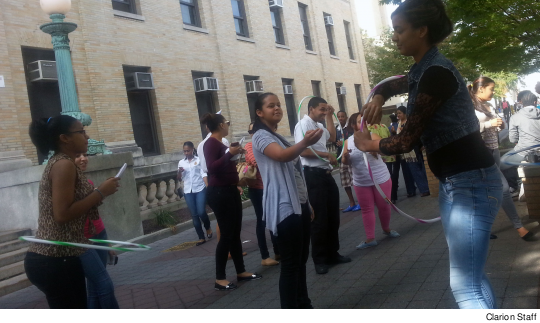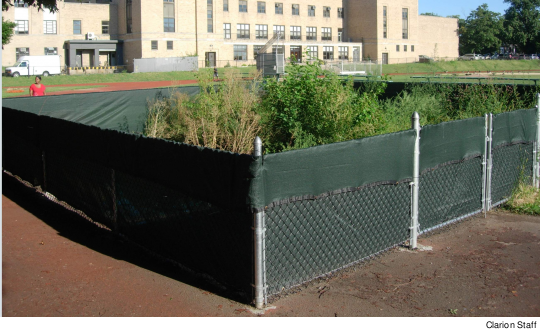The depression in the middle of the running track at Bronx Community College (BCC) was around so long it earned a campus nickname: Sinkhole, Jr. Its larger predecessor, The Sinkhole, had opened up in the middle of a campus road and was big enough to swallow a car. Though smaller, Sinkhole, Jr., was no slouch – it grew to measure 35 feet across and could be seen on Google Earth. The growing gap in the middle of the track left only a single lane on either side, where runners had to pass through single-file.

 |
While the original Sinkhole was repaired five years ago, Sinkhole, Jr., just kept on growing. “Instead of being repaired, a fence was built around it. As [the hole] grew, the fence started to fall into the hole. Instead of fixing the hole, a larger fence was built around it,” a statement from the campus PSC chapter explained. Meanwhile students, faculty and staff at BCC, the first community college in the country to be designated a National Historic Landmark, walked past the eyesore every day.
‘Hole-istic’ Approach
But after eight years of unchecked growth, Sinkhole, Jr., met its end this summer – and the chapter celebrated the victory with an “End of the Sinkhole” party on October 3.
Taking a “hole-istic” approach, PSC members offered donut hole pastries and hula-hoops for a quick morning workout to passing students, faculty and staff. A large photo display showed “before” pictures of the sinkhole and other conditions that have recently been addressed.
The repaired running track is a testament to the persistent organizing and lobbying by BCC’s PSC chapter and evidence of its long fight for capital funds, with more than $30 million now secured. Union members hope that these funds and other recent health and safety fixes will mark a turning point in the problems of disrepair that have long plagued the BCC campus.
“I feel good about stuff getting fixed,” said Jennifer Ortiz, a sophomore math major on her way to morning classes. She had stopped to support her teacher, Leslie deGiere, who led the PSC chapter work in documenting issues and organizing faculty and students to demand more funding for repairs.
“Students wrote letters, sent postcards, called and visited their elected representatives,” said deGiere, in a moment between passing out apple-cider donut holes and urging students to begin their morning with a hula-hoop session under a canopy of trees. (Quite a few did.) “It’s exciting, knowing that our voices got heard and that we can make a change if we work together,” she said.
‘Full-Court Press’
DeGiere refers to the more than 1,000 postcards and dozens of letters that students, faculty and staff mailed this spring to City Council members and the Bronx borough president, urging full funding for capital needs at BCC. The postcards featured photos of conditions in need of repair at BCC, and many faculty, staff and students included photos in their individual letters. PSC members and student activists in the NY Public Interest Research Group (NYPIRG) followed up in April with in-person visits to 10 councilmembers. Soon after, City Council Higher Education Committee Chair Ydanis Rodriguez asked then-Chancellor Matthew Goldstein about BCC’s needs during a public hearing.
The full-court press yielded success: this year BCC’s capital budget is expected to receive $15 million to $17 million at the City level, plus the same amount in matching funds from the State, for a total of about $30 million to $34 million. BCC’s PSC chapter said this amount was “unprecedented.”
President Sets a New Tone
The success this spring was built on organizing efforts in previous years. A 2009 event played an important role in raising awareness on campus about the backlog of overdue repairs. In a photo display dubbed the “Hall of Shame,” a play on the campus’s renowned Hall of Fame with busts of 98 great Americans, organizers chose photos that illustrated the deep contrast between these vaunted American heroes and their crumbling surroundings. In addition to raising the problems regularly at labor-management meetings over the years, in 2011 and 2012 the chapter took a comprehensive census of outstanding repairs and fixes, an effort spearheaded by deGiere. A chapter report in November 2012 pressed for the repair of Sinkhole, Jr.
“It’s taken an enormous amount of work to get this done,” deGiere says, as the tinny sound of a hammer meeting a nail echoed in the air. A short distance behind her, a maintenance worker is on his hands and knees working on the athletic field. “While we’ve made a lot of progress, we’re only 25% of the way there,” she said.
Repairs to date go beyond the sinkhole: they include repair of a broken fire escape at Havemeyer Lab, remediation of mold in that building’s basement, replacement of crumbling pipe insulation in Nichols Hall, and repaired lighting in Meister Hall.
Such gains are due in large part, deGiere says, to the relatively new administration of BCC President Carole Berotte Joseph. “There’s been a marked difference in terms of attitude towards health and safety on campus,” says deGiere, who marks Joseph’s arrival by the rhythm of the campus clock overlooking BCC’s main quad. Before Joseph took office, deGiere explains, the clock was always wrong.
Room for Optimism
John Athanasourelis, a professor of English and an executive committee member of BCC’s PSC chapter, is pragmatic but optimistic about the fate of BCC’s outstanding repairs. Standing back to look at the athletic field, he says, “I can’t even tell you where the hole was.”
A union leaflet sums it up: “Although the race is far from over, we’re on the right track!”
______________________________
PREVIOUS COVERAGE
Turning up the heat at BCC: ‘Hall of Shame’ shocks campus

